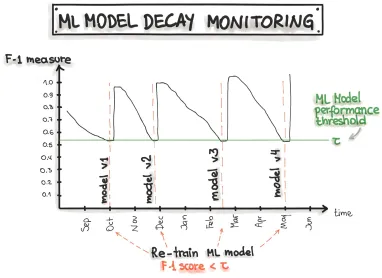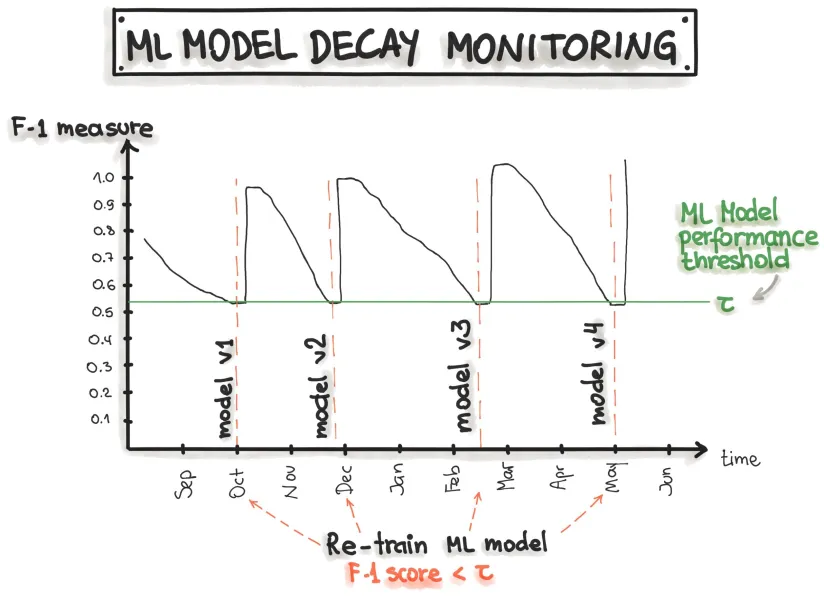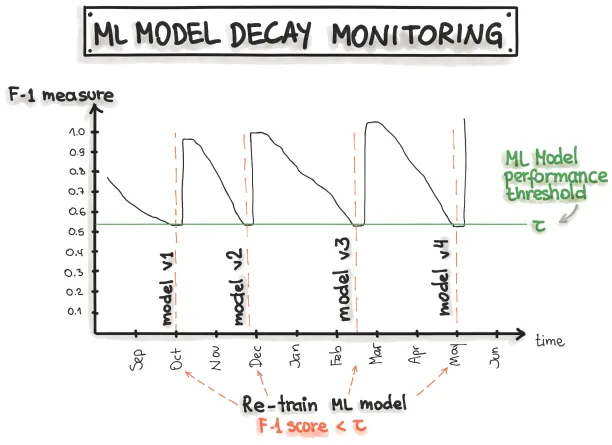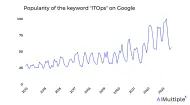Machine Learning Lifecycle: Best Practices for 2024


Building and implementing an artificial intelligence (AI) or a machine learning project is an iterative process. For a successful deployment, most of the steps are repeated several times to achieve optimal results. The model must be maintained after deployment and adapted to changing environment. Let’s look at the details of the lifecycle of a machine learning model.
What is machine learning lifecycle?
The machine learning lifecycle is the process of developing, deploying, and managing a machine learning model for a specific application. The lifecycle typically consists of:
- Determining business objective: The process typically starts by determining the business objective of implementing a machine learning model. For example, a business objective for a bank can be decreasing fraudulent transactions under a certain percentage of total transactions.
- Data collection and exploration: Guided by the established business objective, you collect the relevant data for the machine learning task. Then, you perform exploratory data analysis and data visualizations to understand what the available data provides, and which processes are needed to make the data ready before model training.
- Data processing and feature engineering: The raw data is then transformed to better satisfy the business objective and to make it ready for the model. This stage includes data cleaning, splitting the data into training, validation and test sets, and feature engineering. Feature engineering is the process of transforming data to better represent the business objective. There are AutoML tools that offer automated feature engineering. Other data preparation processes include removing outliers, addressing missing values, masking sensitive data, data labeling, and so on.
- Model training: Then, the developed machine learning model is trained on the prepared training data. Training process is iterative. You can test different machine learning algorithms and training datasets, select the suitable model and fine-tune its hyperparameters to achieve the best performance. Hyperparameters refer to model parameters that influence the learning process (e.g. size of a neural network) that are not inferred from data.
- Model testing and validation: The model is checked against different evaluation metrics such as accuracy to ensure that its predictive performance is adequate for the use case. Before deployment, other potential issues about model performance are addressed such as:
- Excessive resource requirements: The model can consume a large amount of memory or require long processing times. Software engineers and data scientists can work on this problem together to optimize the model performance.
- Insufficient performance: The cost of deploying the model can outweigh its benefits to the business. For example,
- the model may not identify the accuracy of its own predictions accurately. This may require all predictions to be human reviewed if false positives are costly for the process
- the model may not have a high accuracy and therefore offer limited benefits
- Feel free to read our article on ML accuracy for more
- Model deployment: The selected and fine-tuned model is deployed to make predictions. The deployment type can include:
- Online deployment: The model is deployed via an API to respond to requests in real-time and serve predictions.
- Batch deployment: The model is integrated into a batch prediction system.
- Embedded model: The model is embedded in an edge or mobile device.
- Model monitoring: After deployment, the model’s performance is monitored to ensure that it performs well over time. For example, a machine learning model developed a year ago to detect fraud may not capture a new type of fraud if it has not been continuously improved. For models that are trained in specific intervals, a new iteration of the model development process can be launched.

What are the challenges of ML lifecycle management?
- Manual labor: Every step and the transition between steps are manual. It means data scientists need to collect, analyze, and process data for each application manually. They need to examine their older models to develop new ones and manually fine-tune each time. A large amount of time is allocated to model monitoring to prevent performance degradation.
- Disconnection between teams: Data scientists can build sound machine-learning models on their own. However, A 2020 Algorithmia report states that 55% of businesses working with ML models have not deployed a model to production yet. This is because a successful deployment of a machine learning model for a business use case requires data scientists to collaborate with business professionals, designers, software engineers, and other teams. This collaboration makes the deployment process more complex.
- Scalability: As data size or the number of deployed machine learning models grow, it becomes challenging to manage the whole process manually. It may require different teams of data scientists to develop, manage, and monitor each model. So there is a limit for an organization to scale up its machine learning applications while relying on manual processes.
What are the best practices for ML lifecycle management?
Automation of the lifecycle
A successful deployment of machine learning models at scale requires end-to-end automation of steps of the lifecycle. Automation decreases the time allocated to resource-consuming steps such as feature engineering, model training, monitoring, and retraining. It frees up time to rapidly experiment with new models.
Standardization of the process
Data scientists must collaborate with different teams and collaboration requires a common language between teams. Standardization of the ML development and management platform within an organization enables efficient communication between diverse teams.
Continuous training
Real-world data changes continuously. So deployed ML model should also be retrained continuously to maintain model performance.
These best practices are parts of MLOps, a set of practices to increase the efficiency of machine learning applications. Feel free to check our comprehensive guide on MLOps.
If you are looking for vendors that can provide tools to manage your machine learning models, we can help:

Cem has been the principal analyst at AIMultiple since 2017. AIMultiple informs hundreds of thousands of businesses (as per similarWeb) including 60% of Fortune 500 every month.
Cem's work has been cited by leading global publications including Business Insider, Forbes, Washington Post, global firms like Deloitte, HPE, NGOs like World Economic Forum and supranational organizations like European Commission. You can see more reputable companies and media that referenced AIMultiple.
Throughout his career, Cem served as a tech consultant, tech buyer and tech entrepreneur. He advised businesses on their enterprise software, automation, cloud, AI / ML and other technology related decisions at McKinsey & Company and Altman Solon for more than a decade. He also published a McKinsey report on digitalization.
He led technology strategy and procurement of a telco while reporting to the CEO. He has also led commercial growth of deep tech company Hypatos that reached a 7 digit annual recurring revenue and a 9 digit valuation from 0 within 2 years. Cem's work in Hypatos was covered by leading technology publications like TechCrunch and Business Insider.
Cem regularly speaks at international technology conferences. He graduated from Bogazici University as a computer engineer and holds an MBA from Columbia Business School.
To stay up-to-date on B2B tech & accelerate your enterprise:
Follow on

Comments
Your email address will not be published. All fields are required.